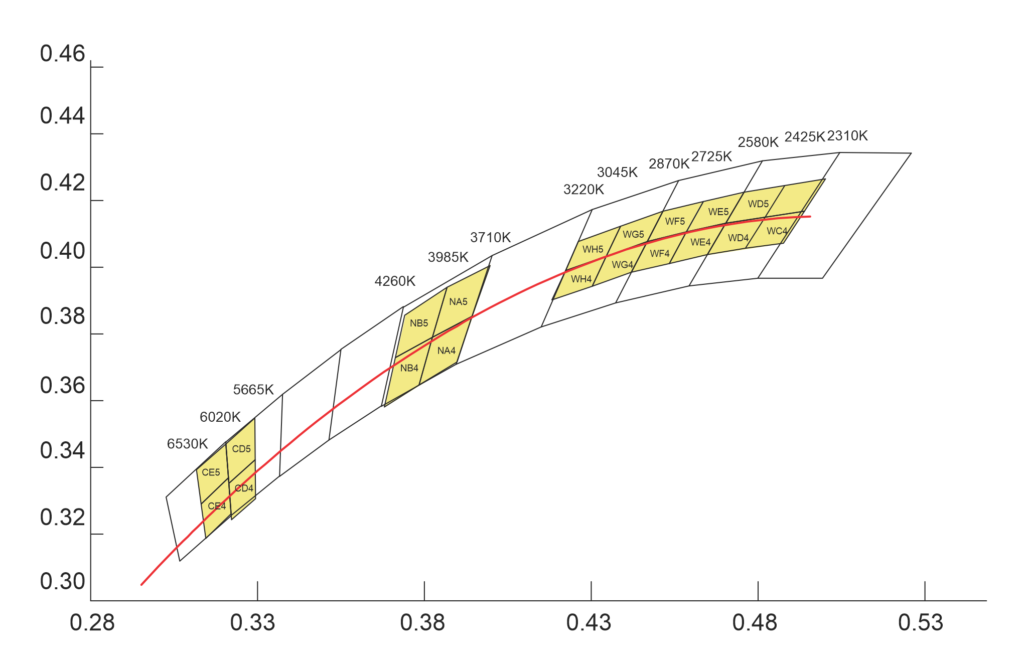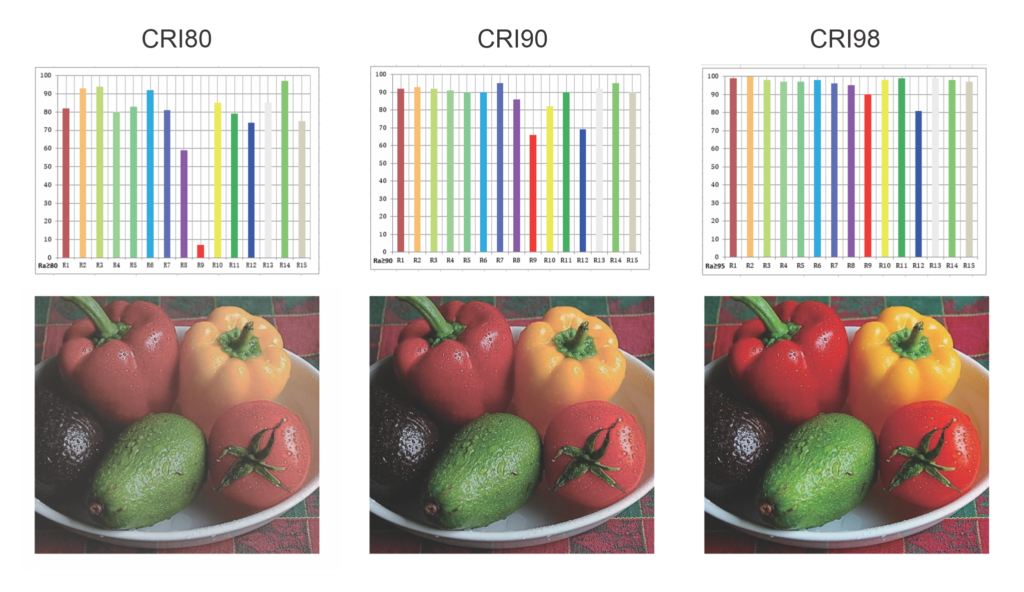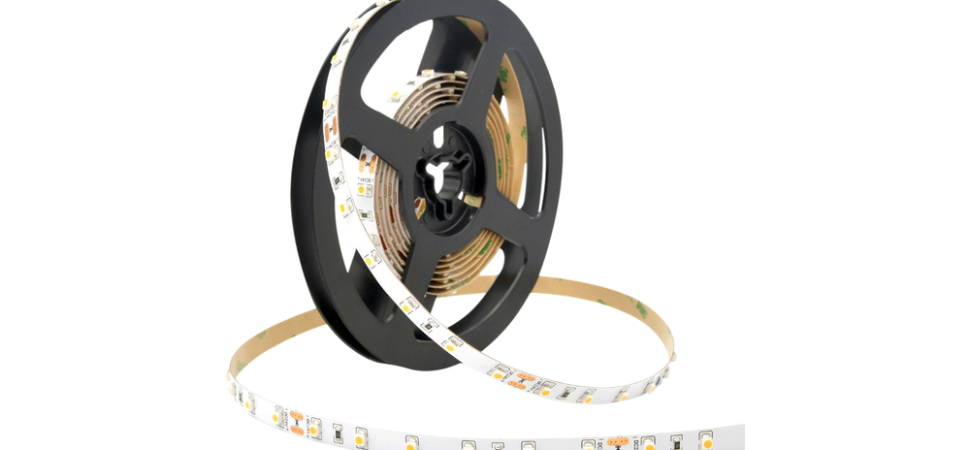Which LED strip should I use?
Flexible LED strip is a modern take on traditional “rope light”, using LEDs as opposed to miniature leaded filament lamps. It is commonly used for under bench, under shelf and concealed pelmet lighting, both interior and exterior. It is almost always low voltage (12 or 24 VDC). Mains voltage LED strip is available, but safety considerations prejudice it’s use.
In a nutshell, LED strip is a length of narrow flexible copper-backed printed circuit board on to which surface mount LEDs and associated components are soldered. The PCB is typically 5-15mm wide, and supplied in 5m rolls. Scissor cut marks are indicated at intervals where the strip may be cut to length, to suit the physical application. Power wires may be soldered to one or both ends.
The decision as to which flexible LED strip to use for your application is relatively straightforward, but a number of factors need to be examined in order to make the best selection.
- Brightness. Is it decorative, or to provide usable light?
- Is it in a dry location, or subject to getting damp / wet?
- What colour of light do you want ?
- Are there physical installation constraints, such as corners?
TAPE WIDTH
Typically, flexible LED strip is made in widths from 5mm up to about 15mm. Strip is sometimes mounted in aluminium profile ( discussed more in a separate article).Some applications call for narrow profile, hence a relatively narrow strip 5mm) is required. As a rule of thumb, 8mm is the standard for single colour tape, 10mm is standard for RGB tape and 14mm is the norm for RGBW tape.
During manufacture, an adhesive film is applied to the back of the tape. During installation, the backing paper is removed and the tape is stuck down to the surface on which it is to be mounted. LED strip does generate some heat: the higher the wattage and light output, the greater the heat. This heat needs to be dissipated away from the strip, hence good thermal contact onto a preferably metal backing is desirable. Make sure all surfaces are clean and free of oil and dirt before sticking the tape down.
Wider tape does provide better thermal transfer, as does a good quality, thickish gauge of copper PCB.
Never operate the tape while it is still coiled up in it’s roll, or it will quickly overheat and be damaged.
BRIGHTNESS / LIGHT OUTPUT
The light output of the tape is directly proportional to the number of LEDs on the strip and the brightness of each LED. Typical densities are 60, 120, 240 LEDs per meter.
The original LED package used in SMD tape was “3528”, which indicates that it measures 3.5 x 2.8mm. This series is still in use, albeit for the more modest performance tape. Still old school, the “5050” package (measuring 5.0 x 5.0mm) contains 3 LED chips ( 6 connection pins ). The 3 chips can be all the same colour (cool white, warm white, R, G, B, Y, etc), or there can be 1 chip each red and green and blue, to make an RGB chip. Despite it’s age, 5050 is still by far the most popular choice for RGB.
The quest is always on for higher light output (lumens) and higher efficiency (lumens/watt).
Higher efficiency means that less power is consumed (smaller and cheaper power supply) and also that less waste heat is produced. This often translates into longer life and more flexible design options because of reduced demands on heatsinking (getting rid of the heat).
In more recent times, market leaders like Osram, Philips, Nichia, etc have developed a whole raft of new models with increased output, efficiency and lifetime. Some examples are 2016, 2020, 3030, 2835.
The 2835 is the now most common LED used in white tape. It is configured most commonly as 60, 120 or 240 LEDs per meter. Most applications suggest that the appearance of LED strip is improved when the LEDs are close together, giving the appearance of a continuous bar of light rather than a dotty effect, increasing the popularity of 120 and 240 LED/m tape.
Light outputs of 1000lumens per metre were once rare, now 1500lm/m is commonplace.
COLOUR TEMPERATURE / CRI
Describing and specifying the appearance of white light is a complicated subject, but vitally important in this discussion. White light can vary from one extreme of candle yellow (warm white) to bluish white (cool white). This property of white light is known as “colour temperature” and is measured in “degrees Kelvin” (°K). Warm white at the yellow extreme is likely around 2300ºK, and bright white at the other extreme is likely up to 10,000ºK.
The colour temperature of a given LED is set at time of it’s manufacture, and is not adjustable.
However, it will vary very slightly depending on how the LED is driven.
Typically, in a domestic environment, cool white is used for working areas such as kitchens and laundries, warm white is used for more relaxing areas such as bedrooms and loungerooms.
Offices tend to be towards the cooler end (between warm and cool is “natural white” or “daylight”) A typical incandescent lamp would have a colour temperature 2500-3000ºK. “Daylight” is a loose definition, opinions ranging from 4500°K to 6500°K.
Flexible tape (and other products such as ceiling downlights) can be available in an “ colour temperature adjustable “ option, which contains both warm and cool LEDs. An external manual controller determines the balance between the two, and hence the final perceived colour.
The science of colour definition is, in reality, far more complicated. Two light sources emitting the same colour temperature can appear vastly different. The science of chromacity diagrams and graphs is the subject of books.

CRI, or colour rendering index, deals with how a given light can adjust the perception of colours.
It is represented by a number up to 100, 100 being perfect. If a coloured object is lit by a light source with low CRI, it’s colour will not be truly represented. It is often an issue with lights used for food display. LEDs typically used in flexible tape have a CRI of 80 or better, some reaching as high as 95 (with associated cost penalty).
When LED strip is installed, it may be important to be able to “colour match” later on if replacement or addition is required. While the customer may specify, say, 4000°K initially and then request the same colour temperature a year or two later, the two products may look considerably different when placed side by side. The manufacturer of Linear Lux tape also manufactures and grades the LED components, and guarantees that we will consistently receive LEDs from the same colour bin from batch to batch.

12V or 24V CUTTING LENGTH
The PCB pattern on the strip will be generally laid out for either 12V or 24V supply. An “increment” of 12V tape will include 3 LEDs and 1 or 2 resistors, for 24V it will be 6 LEDs and 2 or more resistors. The resistors are included so that the tape can be used in quasi constant voltage mode (see CONSTANT CURRENT / CONSTANT VOLTAGE blog).
Depending on the packing density (60 or 120 LEDs/m, etc) this block of 3 or 6 LEDs can be typically 25, 50 or 100mm long. The start / finish lines between adjacent blocks of LEDs is marked on the tape with a line or scissor mark, indicating where the tape can be cut. If you cut other than on a mark, some or all LEDs will not light.
Bridging over the cut mark are solder pads for electrical connection.
Like for like tape, 12V has the obvious advantage of half the cutting distance of 24V. This allows for greater flexibility in installation. However, the 12V tape will use twice the current of equivalent 24V tape, so the voltage drop at the far end of the 12V tape will be twice that of the 24V. Over long lengths, the far end of the 12V tape will be more likely to be duller than the supply end.
For long lengths, one option to relieve this problem is to supply power from both ends of the tape. A further benefit of 24V is that the current in the supply wiring is only half that of a similar 12V installation, and hence voltage drop for 24V is not only half, but it’s effect is less because of the higher voltage.
IP RATING
Basic flexible tape, consisting of LEDs and resistors soldered on to flexible copper PCB with an adhesive film, will be damaged by water or other liquids (IP20 rating). Therefore, in cannot be installed in wet or moist environments. To obviate this problem, the strip can be enclosed in a transparent, flexible silicone tube / sleeve (IP67), or it may be “painted” with a thick and durable layer of liquid silicone (which then sets to a flexible coating) (IP54).
To maintain the integrity of the enhanced IP rating, joins, ends and wire terminations must be similarly enhanced.
Typically, IP54 strip, with the “drip silicone” domed top is considered suitable for damp environments. For more demanding applications, IP67 must be specified.
BENDING PLANE AND SOLUTIONS
Standard LED tape is bendable in only one plane. Great care should be exercised with sharp angles to ensure that undue strain is not placed on the component solder joints. Should a joint be damaged, that section (3 LEDs or 6 LEDs) will not light up. Should the tape be required to be bent in the other plane (for example on the face of a mirror shining outwards), the tape will need to be cut, the two sides of the right angle needing to be joined by a short wire jumper (soldered). All times, LED tape should be handled gently and with care. Fixing dead spots can be frustrating and tedious.
Flexible tape can be produced in “ side emitting “ format where, instead of shining “ outwards “, it shines up or down.
“Flip LEDs” is similar to above, using LEDs which are individually bendable to the desired angle.
“Zig zag LEDs” use an intricately cut and more flexible PCB material to enable the tape to more easily fit into irregular shapes, for example, letters and numbers.
OTHER CONSIDERATIONS
While tape is typically supplied in 5m rolls, some applications require longer lengths in one piece. It’s not quite as simple to extend the length by merely joining one piece to another. The major issues are the current carrying capacity of the strip, and the voltage drop from one end to the other. If this drop is too great, the reduction in brightness at the remote end can become quite noticeable. As mentioned above, one solution is to supply power from both ends. For further extending the length, power can be “injected” at the 5m join points.
Another possible solution is to use “constant current” tape, where miniature regulator components are used along the strip to achieve a more uniform current, and hence brightness.
20m lengths are advertised, but it is not popular because of the considerably increased cost.
The only way to consistently achieve solid connections to tape is by soldering. There are a number of press or snap fittings used to join tape in either a linear fashion or at rightangles, but their long term integrity is always questionable.






